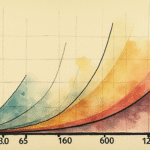Who is Claudia Sheinbaum?
Claudia Sheinbaum Pardo is the current Head of Government (equivalent to a mayor) of Mexico City, serving since 2018. Previously, she was the Secretary of Environment from 2012 to 2018. Her role in Mexico City’s administration places her at the forefront of addressing urban issues, including the city’s economic health.
Mexico’s Economic Performance
According to data from Mexico’s National Institute of Statistics and Geography (Inegi), Claudia Sheinbaum has asserted that Mexico’s economy is solid. The Gross Domestic Product (GDP) grew by 0.7% in the second quarter, 1.2% annually, and accumulated 0.9% in the first half of 2025. Based on these figures, the International Monetary Fund (IMF) revised its forecast for Mexico from -0.3% to +0.2%.
IMF’s Revised Forecast
The IMF acknowledged that its revised estimate was based on better-than-expected domestic data, a more favorable financial environment, and the fact that US tariffs hadn’t been applied at the time of their estimation. However, they did not consider one of Mexico’s primary and imminent risks: Trump tariffs.
External Factors and US Economy
The observed growth might also be explained by extraordinary and temporary external factors. In the United States, the GDP grew 3.0% annualized in the second quarter after falling 0.5% in the first. However, this uptick was misleading: many US companies expedited foreign purchases, including those from Mexico, to circumvent Trump tariffs. Since these purchases occurred in the first quarter, second-quarter imports dropped. As GDP is calculated by subtracting imports from total output, a decrease in imports can artificially inflate growth without increased production. The real internal demand in the US grew only 1.2%, its slowest pace since 2022.
Mexico’s Growth Benefiting from Export Advancements
This suggests that Mexico’s growth might have also benefited from the temporary advancement of exports. If so, this impetus could disappear in the third quarter when new tariffs start impacting.
Uncertainty Surrounding Tariffs
As of the writing of this article, no details are available about the tariffs set to take effect tomorrow. The tariff rate—whether 15%, 20%, 25%, or 30%—the affected products, and any potential exemptions remain undefined. The situation remains unclear. Marcelo Ebrard, Mexico’s Foreign Affairs Secretary, was unable or unwilling to provide information when questioned about it last Tuesday.
Potential Consequences
The potential repercussions are significant. A 15% tariff could subtract nearly a point from GDP growth. A 25% tariff would imply a contraction of at least 1.5 points. If the 30% tariff is applied, the GDP could fall between 2% and 3%, resulting in losses of 1 to 3 million formal jobs, particularly in key sectors like automotive, electronics, and agroindustry. Additionally, the investment climate could worsen if there’s a perception that the government lacks a firm strategy to mitigate these effects.
Mexico’s Vulnerabilities
Sheinbaum has repeatedly expressed confidence in the Plan Mexico and announced investments, though these are long-term. In contrast, tariffs will have immediate and visible effects, starting with corporate decisions.
Distinguishing Between Stability and Solidity
Maintaining controlled inflation and organized finances is positive, but it doesn’t shield the country from external shocks. Rather than celebrating preliminary figures, it’s essential to present strategies to minimize the impact of Trump tariffs.






